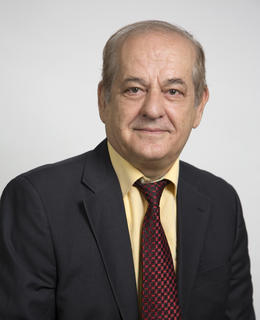The 6th International
Symposium on Thermal-Fluid Dynamics
(ISTFD 2025)


The 6th International
Symposium on Thermal-Fluid Dynamics
(ISTFD 2025)

Prof. A.A. Mohamad
Dept. of Mechanical and Manufacturing Engineering, Schulich School of Engineering, The University of Calgary, Calgary, Alberta, T2N 1N4, Canada
E-mail: xwang3@iastate.edu
Bio
Dr. Majeed Mohamad is a Mechanical and Manufacturing Engineering professor at the University of Calgary, Canada. He was the Interim Director of the Centre for Environmental Engineering for Research and Education (CEERE). Dr. Mohamad is an ASME fellow and Executive Scientific member of the International Center for Heat and Mass Transfer (ICHMT). Dr. Mohamad's research area spans different aspects of thermal sciences and engineering. He has extensively contributed to heat and mass transfer fundamentals in natural convection, combustion in porous media, flow and heat transfer in liquid metals, solar energy, adsorption/desorption, thermal radiation, etc. His work on solar energy resulted in developing a high-efficiency solar air heater. Also, his work on combustion in the porous medium resulted in an ultra-low NOx burner. Dr. Mohamad published over 350 papers, mainly in peer-reviewed journals.
Dr. Mohamad extensively contributed to computational fluid flow, heat, and mass transfer. He authored a popular textbook on the Lattice Boltzmann Method, Fundamentals, and Engineering Applications with Computer Code. Springer published the book's second edition in 2019, which was also translated into Chinese. He also co-authored a textbook, Numerical Methods for Engineers, 2024.
Dr. Mohamad founded the International Conference on Computational Heat and Mass Transfer (ICCHMT) and Applications on Porous Media. The 15th edition of ICCHMT was held in Antalya, Turkey, in May 2025.
Many universities and institutes worldwide have invited Dr. Mohamad to be a visiting professor, lecturer, keynote speaker, Ph.D. thesis examiner, program evaluator, and collaborator.
While on special leave from the University of Calgary, he was acting Dean of Engineering at Alfaisal University in Saudi Arabia. He was instrumental in establishing an engineering school there.
In recognition of his contribution, the Int. J. of Heat and Mass Transfer published an article on his 65th birthday. He holds a few awards: the APEGA Summit (technical, Frank Spragins) Award, 2025; Excellence Graduate awards (2025, 2021, 2007); Aveeoes Award, 2017; and Research Excellence Award, 2003.
Title
Fluid Dynamics of a Liquid Metal Droplet
Abstract
High-power electronics and laser systems often require heat dissipation exceeding 200 W/cm². Phase change processes like boiling and condensation can manage high heat fluxes but may introduce reliability issues due to volume and pressure fluctuations. Liquid metals, with their superior thermal conductivity, offer a promising alternative.
Gallium-based liquid metals stand out due to their unique combination of high electrical conductivity, low melting point, and high surface tension. These properties make them attractive for emerging technologies such as flexible electronics, soft robotics, and adaptive materials. This body of research investigates the dynamic behavior of gallium-based liquid metals, focusing on their impact and response under controlled, non-oxidizing conditions that preserve their native fluidic characteristics.
The talk presented here explores the isothermal fluid dynamics of liquid metal droplets impacting solid surfaces. Understanding these dynamics lays the foundation for studying non-isothermal systems. In particular, we examine droplet impact and splashing behavior on superhydrophobic surfaces in viscous environments. The deformation patterns observed reveal distinct dynamics compared to conventional fluids, driven by the metal's high surface tension and density.
Critical parameters influencing the transition from deposition to splashing are identified, emphasizing the roles of the Weber and Reynolds numbers, adapted to account for the high density and viscosity of liquid metals. These findings highlight the unique fluid mechanics of gallium-based alloys and underscore their potential in advanced thermal management and reconfigurable systems requiring precise, responsive control.